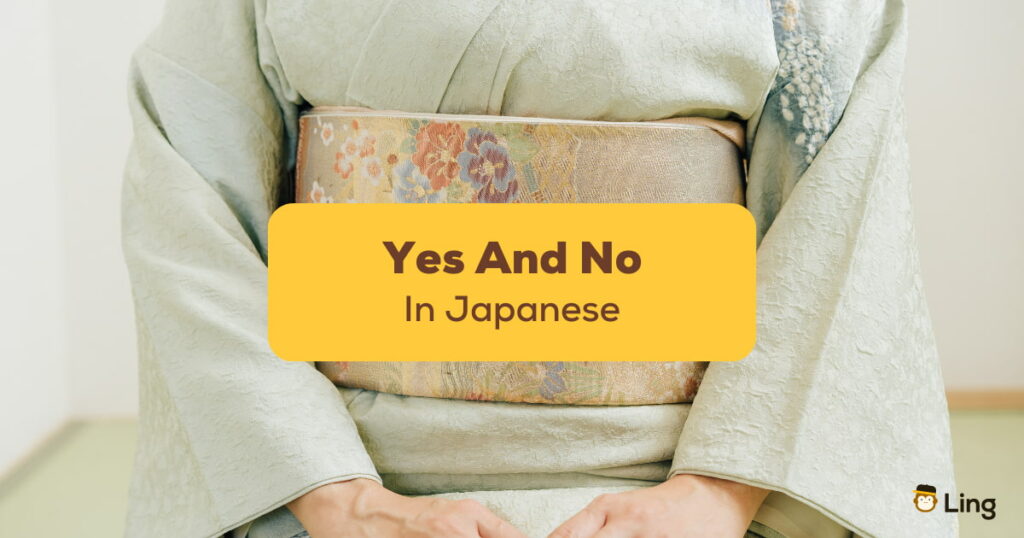Are you planning to visit Japan soon? If you are, then it is impossible not to find a situation where you won’t say はい and いいえ or yes and no in Japanese. While you can use non-verbal gestures like shaking your head or giving a thumbs down or up, using words can help you make yourself more understandable to the locals.
These two words may seem simple, but they are vital, as there are cultural meanings that you surely do not want to step on. After all, the Japanese language is not simple. Let’s learn a little more about this in today’s post.
Yes And No In Japanese Culture
Just like in many languages, there are several ways by which you can say yes and no. Depending on the tone and the gesture you will use while saying it, the meaning that will be transferred to your listener can greatly change, which is why using the correct Japanese words at the right moment will be a good start for you.
Before we proceed, remember that the locals have formal and more casual words to use depending on the context, so choose your words wisely.

How Do You Say Yes In Japanese?
The most straightforward translation for the word “yes” in Japanese is はい pronounced as hai . It is the most recommended word to use since it is polite and perfect, may it be when you speak with your close friends or in the workplace.
Another translation that you can use for a more casual way of saying yes is ええ pronounced as eh . This is the best word to use when speaking with a close friend or someone who is younger than you. Don’t use this one with your workmates, boss, or strangers, as this will sound rude.
If you are interested in answering even more casually, you can use うん un to express your agreement with something. More often than not, this is the translation for “yeah” in the English language. Do not use this when speaking with a teacher, a boss, or a stranger, as this can rub off the wrong way.
Is There A Word For No In Japanese?
There are three easy ways to say no in Japanese. The most direct translation for saying no in a polite way is いいえ iie . It is perfect to use in casual situations and is a straightforward answer. In the Japanese culture, saying no in certain instances is deemed to be inappropriate as the locals always want to extend their respect to other people. So, instead of directly saying no, they sometimes just end up apologizing instead.
Another way to say no when talking with your close Japanese friends is to say いや iya . This word is informal and should only be used with people you really are close with, as this sounds very informal.
Lastly, you can also use ううん uun to say no when speaking with family and friends. Do not ever use this when speaking with people of high authority.

Learning More About Japanese Yes And No Words
As we reach this part of the post, we hope that you were able to learn about the positive and negative responses in Japanese that you can use today. As we have shared above, please be careful with the words you use, which is why you have to take note of whether it is the polite way or the more casual version in order to prevent sounding rude.
If you are an advanced learner of the Japanese language, then you might know that there are also many ways by which you can say yes and no, depending on the context. The ones we have presented here are straightforward versions.
Suppose you are interested to learn more about Japanese culture, language, and tradition. In that case, we highly recommend that you check out our previous posts, which are guaranteed to help you express yourself better with confidence.
Some of our most-read topics on the site include answers to questions like what are the most useful Japanese languages to learn, or whether the language itself is a bit difficult or not. You can even learn the common slang vocabulary used by the locals!
Now, if you feel that you want to jump into a meaningful conversation with a native speaker right away, then checking out the impressive Ling app is necessary.
Through this powerful platform, you can learn not just the most basic way to start speaking Japanese the right way, but you will also get bits of information about the culture and traditions of the people speaking your target language. With it, you can improve your reading, writing, speaking, and listening skills for free! Interested in exploring what it is? Read on below!
Ready To Start Learning Japanese Words And Expressions?
The Japanese language is one of the hardest languages out there as it not only uses one writing system but three different ones (hiragana, kanji, and katakana)! So it should be great to learn more than just yes and no in Japanese, right?
On top of that, the language is tricky because a single mistake in the pronunciation and choice of words can make or break your chances of connecting with the locals in the right way. As a rule of thumb, do remember that you can easily be friends with Japanese people if you consider showing politeness and respect through your way of speaking.
If you are truly ready to challenge yourself and learn the correct words and translations to use, then the Ling app has your back. The Ling app is a language learning platform guaranteed to help develop your confidence in Japanese and 60+ other foreign languages.
What sets it apart is its gamified content that teaches you the meaning of words and helps you understand them more deeply. Thanks to the help of language professionals and native speakers, the lessons inside will help you create a meaningful statement right away.
Discover the Ling app‘s unbeatable power today! Download the app from the App Store and Play Store today, try it out for free, and make your travel to Japan extra memorable!









































